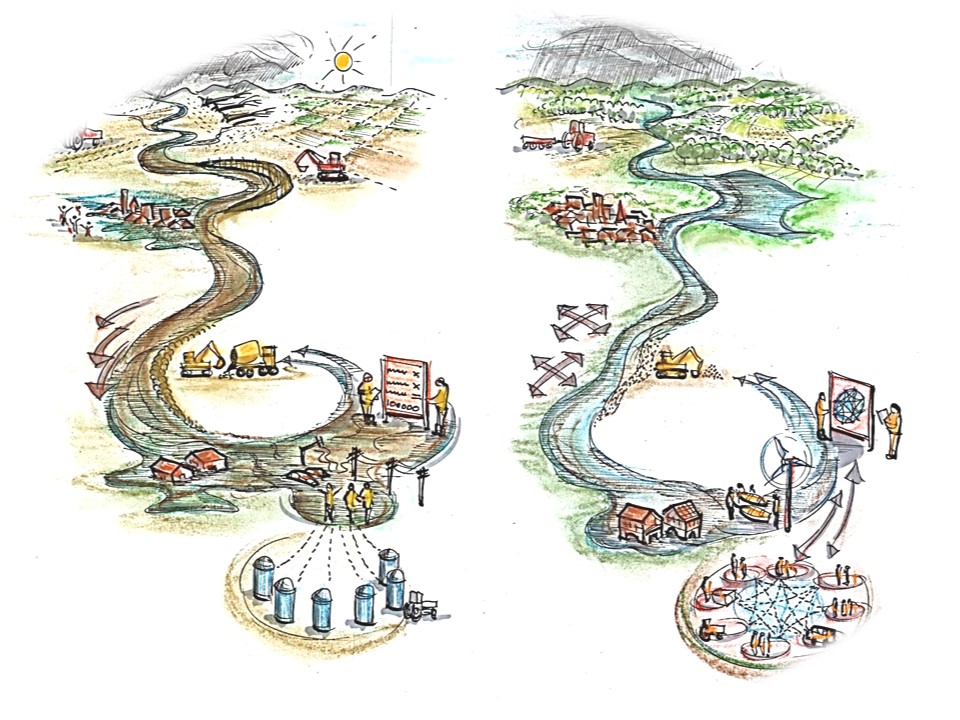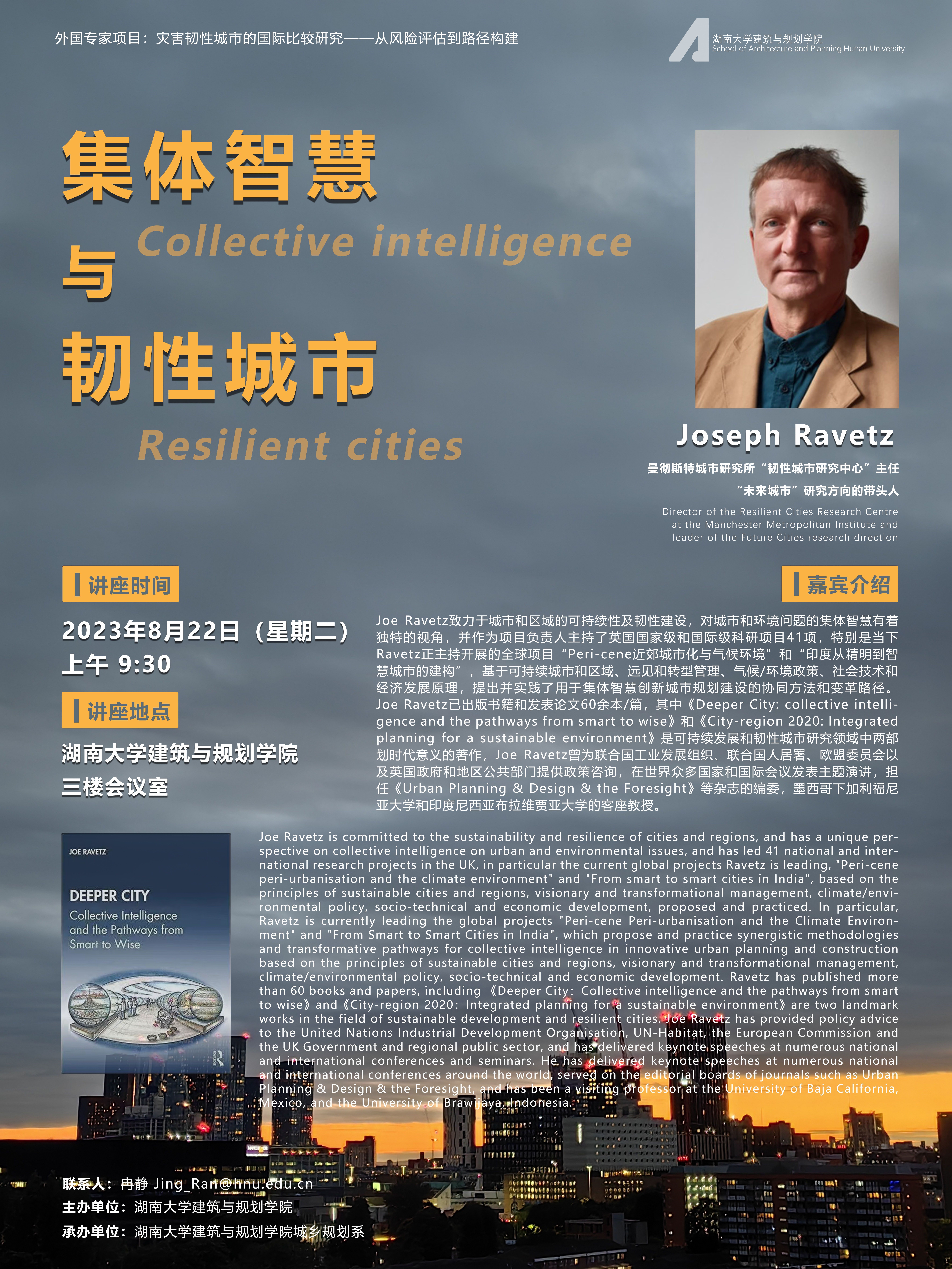Planetary urban resilience
or, ‘how to survive the 21st century’
“An international comparison study of hazard resilient cities: From risk evaluation to developing pathways” , funded by the Ministry of Science and Technology in China,
Partners: Hunan University, China: University of Manchester UK: Cardiff University UK: University of Illinois USA
The ‘resilient city’ is urgent and topical – extreme flooding in China and Germany – extreme wildfires in Canada and Australia – extreme drought and famine in East Africa – extreme heat in UK China & USA….
in this China-UK-USA project on International Resilient Cities, we are developing new methods of risk analysis and resilience pathway design. This includes 3 workshops:
- (1) risk analysis & resilience pathway design (21st July: Manchester): see Urban resilience – workshop 1 – pathway design
- (2) international review & policy applications (21st August: Changsha): mapping the ‘8 varieties of resilience’
- (3) project review & next steps (December 2023 tbc, online).
Also –
- 3 papers are in progress, following up or parallel to this theme;
- A scheme for a ‘Res-Lab (‘collective resilience intelligence laboratory’) is emerging, based on these ideas. A follow up meeting is planned in January (hybrid tbc), to prepare for major EU funding proposal
Workshop 1: urban risk analysis & resilience pathway design
University of Manchester (with online option) Friday July 21st 2023, 12-1500 BST
This workshop aimed to compare and learn from cities facing natural hazards and disasters, including: Greater Manchester (UK), Changsha & Wenchuan (China), Cape Town (SA), Puerto Rico and/or Chicago (USA).
We aim to analyse the underlying risks, both direct and system-wide: and explore potential pathways, both ‘problem-fix’ and ‘transformative resilience’. In this Manchester workshop we bring together 6 international examples, with a focus on the GM city-region and first hand experience of both climatic risks and resilience pathways.
See full report on – Urban resilience – workshop 1 – pathway design
PROJECT METHODS
‘Planetary urban resilience’ is a far-reaching but practical agenda. It follows the simple logic of a river system – to understand and manage the urban system and the urban flood risk, we have to look upstream and downstream of the city. Similar principles apply to other hazards, both natural and human-made. For the example of flooding,
- Upstream, the peri-urban fringes and rural hinterlands may be deforested and degraded, each contributing to urban flood events;
- In the central urban areas, internal conditions are shaped by external systems of landowning and social ordering, all of which then contribute to social and economic vulnerability;
- Downstream, typical ‘problem fixing’ flood management then generates further hazards for other communities, all the way to the sea.
- On a planetary basis, the extraction of resources and disruption of ecosystems, even in the most remote areas, both feeds the global urban system and increases its vulnerability to the effects of such disruption.
The methodology here follows the ‘synergistic approach’ and ‘pathways toolkit’, as in Collective intelligence & the pathways from smart to wise (Ravetz 2020). This can work for both ‘problem analysis’ and ‘pathway design’, as in this extract on Resilience-III
- System mapping – focus on the cognitive interactions of a wider set of actors (stakeholders): further set of factors (causal chains): and deeper domains (multiple systems of value and logic);
- Co-evolutionary mapping of these systems, into 2 main types: ‘functional’ / technical systems: and cognitive / societal systems, based on a ‘collective resilience intelligence’;
- This ‘collective resilience intelligence’ is the key insight here: basically this means, the capacity for collaborative learning, communication, co-creation and co-production, between a wider set of actors, with further horizons of change, and with deeper layers of value and logic;
Following that, we learn from experience how this collective resilience intelligence works in practice. We often see that ‘some are more winners than others’. We can explore with synergistic mapping such ‘big bad world’ dynamics, such as…
- colonization & expropriation – e.g. where urban climate adaptation includes moving slum settlements to make way for high value real estate (e.g. Chennai, Cartagena);
- hijack & weaponization – e.g. where climate adaptation / water management is a eco-political football, in the contest of rural indigenes vs urban cosmopolitans (e.g.Farmer-Citizen in the Netherlands, AFD in Germany)
Such processes can be seen everywhere, from local disputes to global climate policy (see Climate-wise and Eco-War pages). These are almost intractable problems with few ‘fixes’. The need is ever more urgent, for transformative pathways in whole-system resilience. This project is a small step in that direction.
PROJECT BACKGROUND
From the project brief… “The ‘resilient city’ has become the focus of current research on disaster prevention and mitigation and urban safety construction.
The frequent occurrence of major natural disasters and world-class public health emergencies of COVID-19 in recent years have made people realize more clearly that cities of the future, especially those with high-density development, are facing increasingly serious risks and challenges. For example, in 2020, the new coronary pneumonia caused 79,000 people to live in isolation tents in New York City alone [1] (as of October 2020), and the tropical cyclone in 2021 displaced more than 200,000 people in Gujarat, India. At the same time, the new coronary pneumonia and white fungus were superimposed of the spread, hospital beds are far from enough. The flood in Zhengzhou in 2021 caused emergency relocation of millions of people across the province, and over 400,000 flooded vehicles were waiting to be dealt with [2]. The tropical cyclone in the Philippines in 2019 caused 342,000 people to become homeless [3]. In this context, “building inclusive, safe, resilient and sustainable cities and human settlements” was identified as an important global goal for 2030 by the United Nations Sustainable Development Summit (2015).
More than 70% of the cities and more than 50% of the population in China are located in areas with severe natural disasters such as meteorology, earthquakes, geology and oceans [4, 5]. In the “National Assessment Report on Management and Adaptation of Extreme Weather and Climate Events and Disaster Risks in China” issued by 12 government departments, including the National Health and Family Planning Commission, the Ministry of Environmental Protection, the Chinese Academy of Sciences, the Academy of Social Sciences and related universities, it is estimated that high temperature, floods and floods in China in the mid-21st century The risks of major disasters such as drought, landslides, debris flows, and earthquakes will increase significantly, and the risks will be superimposed and amplified with the benefits of high-density urban construction, agglomeration of economic development, aging population structure, and significant regional differences. 5, 6]. In this context, President Xi proposed in his report to the 19th National Congress of the Communist Party of China to “establish the concept of safe development and promote the idea of life first and safety first”.
It can be seen from the above-mentioned domestic and foreign strategic goals that urban security has become an important issue to be solved urgently in the future. However, disasters and security events have the characteristics of unknown, rare, uncertain and small probability, and the complexity of the city determines that this problem is a comprehensive regional planning, environmental science, engineering, ecology, geography Systematic research in many fields such as public administration and policy research. The concept of resilient city has been widely used in the study of coping strategies of urban systems in the face of unpredictable future acute shocks and chronic pressures due to its connotative characteristics such as dynamics, co-evolution, and “returning to a better state”. The current research focus of disaster prevention and mitigation and urban safety construction. Therefore, the “China Emergency Management Innovation Forum” held in China in 2017 put forward the forward-looking and innovative requirements of “accelerating the construction of a compact urban safety system suitable for my country’s national conditions, and providing a Chinese version of the theoretical support for the internationally popular resilient cities”.
Under the test of the public health security incident of COVID-19, many cities in China have shown resilience characteristics such as excellent response speed, anti-disturbance ability, self-organization ability, synergy and creativity. Existing research has not yet explained the underlying mechanism of urban resilience in China and how it is different from Western countries. Therefore, this research will contribute the literature of hazard resilient cities by comparing the experience and cases of urban systems in China and other countries, regarding their response in disasters and emergencies, and their various pathways from disaster risk assessment to resilience construction.
PROJECT AIMS & PLANS
The overall goal of this project is to compare the differences in disaster risk assessment methods and resilience construction pathways between urban systems in China and other countries in the world, to analyze the deep impact mechanism of social, economic and institutional differences on the formation of urban resilience, and to summarize the experience of urban resilience in China.
The above objectives are planned to be accomplished in three phases. In the first phase, several case cities will be identified, and a comparative study plan will be conducted by collecting and analysing relevant policy documents and materials. In the second phase, a work camp is carried out to conduct in-depth horizontal comparative research between China and foreign countries, and to discuss typical case countries and city risk assessments Methods and resilience construction path. In the final phase, it will summarize the construction path of China’s resilient city, and conduct international knowledge exchanges.
Throughout the two years of the project schedule (2022-2023), collaborators from Manchester University, Cardiff University and the University of Illinois, Chicago will work together with the Chinese researchers (PI Jing Ran from Hunan University) to complete the comparison study of international experience in hazard resilient cities. The collaboration can be carried out in the form of online and offline meetings, lectures, consultations, and workshops.


